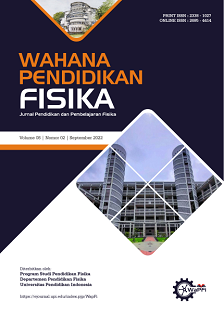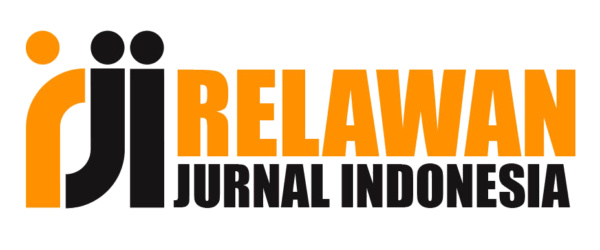High Order Thinking Skills of Grade XI Students using the Flipped Classroom Reading Assignment and Flipped Classroom Video Methods on the Kinetic Theory of Gas
Abstract
This research is motivated by the low level of thinking skills of students in Indonesia based on the results of the Indonesia National Assessment Program (INAP) study and also the 2018 Programme for International Student Assessment (PISA). These high order thinking skills can be improved by implementing flipped classroom learning. The study aims to provide an overview of the improvement of high order thinking skills using different flipped classroom pre-class activities, namely learning videos and text reading assignments. This study used a two-group pretest-posttest design, with a sample of students from one of the schools in Cimahi City, the number of research samples was 34 for the first experimental class using text reading assignment and 35 for the second experimental class using video learning. The instruments used were pre-test and post-test of students' high order thinking skills in the form of reasoned multiple choice, implementation observation sheet, pre-class quiz task and LKPD. The analysis technique used descriptive statistics, N-Gain calculation and independent t-test. The results showed that both flipped classroom reading assignment and flipped classroom video methods can improve students' high order thinking skills in the medium category, with a high N-Gain on flipped classroom video (0.51) compared to flipped classroom reading assignment (0.40). Then, the results of the independent t-test test obtained a value of 0.007, this value is smaller than the significant level (𝛼 = 0.05), so it is concluded that there is a significant difference in students' high order thinking skills after learning by using the flipped classroom reading assignment learning method and the flipped classroom video learning method. Overall, the flipped classroom video method also showed better performance than the flipped classroom reading assignment on the pre-class quiz and LKPD results.
Keywords
Full Text:
PDFReferences
Al Hakim, A. (2023). Implementation of the Flipped Classroom Learning Model for Reading Procedure Text Material during the COVID-19. Jurnal Praktik Baik Pembelajaran Sekolah dan Pesantren, 2(03), 117-127.
Battaglia, D. M., & Kaya, T. (2015). How Flipping your first-year digital circuits course positively affects student perceptions and learning. International Journal of Engineering Education, 31, 1126–1138.
Blair, E., & Primus, S. (2016). Performance and Perception in the Flipped Classroom. Education and Information Technologies, 21(6), 1465–1482.
Chen, T., Luo, H., Wang, P., Yin, X., & Yang, J. (2023). The role of pre-class and in-class behaviors in predicting learning performance and experience in flipped classrooms. Heliyon, 9(4).
Chen, H. J., Chen, C. H., & Wu, W. C. V. (2025). Effects of Flipped Learning on Language Learning Outcomes: A Meta-Analysis investigating Moderators. SAGE Open, 15(2), 21582440251331298.
Deng, R., Feng, S., & Shen, S. (2024). Improving the effectiveness of video-based flipped classrooms with question-embedding. Education and Information Technologies, 29(10), 12677-12702.
Freahat, N. M., & Smadi, O. M. (2014). Lower-order and higher-order reading questions in secondary and university level EFL textbooks in Jordan. Theory and Practice in Language Studies, 4(9), 1804-1813.
Gilboy, M. B., Heinerichs, S., & Pazzaglia, G. (2015). Enhancing Student Engagement Using the Flipped Classroom. Journal of Nutrition Education and Behavior, 47(1), 109–114.
Han, E., & Klein, K. C. (2019). Pre-Class Learning Methods for Flipped Classrooms. American Journal of Pharmaceutical Education, 83(1), 6922.
Hindriana, A. F., Jaelani, A. J., Setiawati, I., Wulandari, I., & Priantama, R. (2023). Analysis of Elementary and Junior High School Teachers’ Understanding of National Assessment in the Kuningan District. Jurnal Penelitian Pendidikan IPA, 9(5), 2505-2513.
Jensen, J. L., Holt, E. A., Sowards, J. B., Heath Ogden, T., & West, R. E. (2018). Investigating Strategies for Pre-Class Content Learning in a Flipped Classroom. Journal of Science Education and Technology, 27(6), 523–535.
Krathwohl, D. R. (2002). A Revision of Bloom’s Taxonomy: An Overview. Theory Into Practice, 41(4), 212–218.
Lai, C.-L., & Hwang, G.-J. (2016). A self-regulated flipped classroom approach to improving students’ learning performance in a mathematics course. Computers & Education, 100, 126–140.
Lamada, M. S. (2022). Evaluation in Assessment of Student Competence: Application of the Indonesian Student Competency Assessment (AKSI) in Elementary Schools. International Journal of Environment, Engineering and Education, 4(2), 66-72.
Lo, C. K., & Hew, K. F. (2017). A critical review of flipped classroom challenges in K-12 education: possible solutions and recommendations for future research. In Research and Practice in Technology Enhanced Learning (Vol. 12, Issue 1). Springer.
Mas’ud, H., & Surjono, H. D. (2018). The Implementation of Flipped Classroom Learning Model Using Moodle To Increase Students’ Higher Order Thinking Skills. Journal of Educational Science and Technology (EST), 1(1), 187.
Purba, R. B., & Sinaga, A. I. (2024). The Developing a Fiqh Student Worksheet Based on Problem-Based Learning to Improving Critical Thinking Skills. JIE (Journal of Islamic Education), 9(1), 309-325.
Randolph-Bean, J. M. (2025). The Power of Access: Flipping Instruction Using Students’ Native/Home Languages in a Secondary ESOL Algebra Classroom (Doctoral dissertation, University of Georgia).
Smith, J. D. (2013). Student attitudes toward flipping the general chemistry classroom. Chem. Educ. Res. Pract., 14(4), 607–614.
Sun, J. C.-Y., Wu, Y.-T., & Lee, W.-I. (2017). The effect of the flipped classroom approach to OpenCourseWare instruction on students’ self-regulation. British Journal of Educational Technology, 48(3), 713–729.
Yilmaz, R. M., & Baydas, O. (2017). An examination of undergraduates’ metacognitive strategies in pre-class asynchronous activity in a flipped classroom. Educational Technology Research and Development, 65(6), 1547–1567.
Zainuddin, Z., & Halili, S. H. (2016). Flipped Classroom Research and Trends from Different Fields of Study. The International Review of Research in Open and Distributed Learning, 17(3).
DOI: https://doi.org/10.17509/wapfi.v10i2.60215
Refbacks
- There are currently no refbacks.
Copyright (c) 2025 Universitas Pendidikan Indonesia (UPI)

This work is licensed under a Creative Commons Attribution-ShareAlike 4.0 International License.
The Journal Wahana Pendidikan Fisika http://ejournal.upi.edu/index.php/WapFi/ is licensed under a Creative Commons Attribution-ShareAlike 4.0 International License
The Journal WaPFi (Wahana Pendidikan Fisika).
All rights reserverd. pISSN 2338-1027 eISSN 2685-4414
Copyright © Faculty of Mathematics and Science Education (FPMIPA) Universitas Pendidikan Indonesia (UPI)










